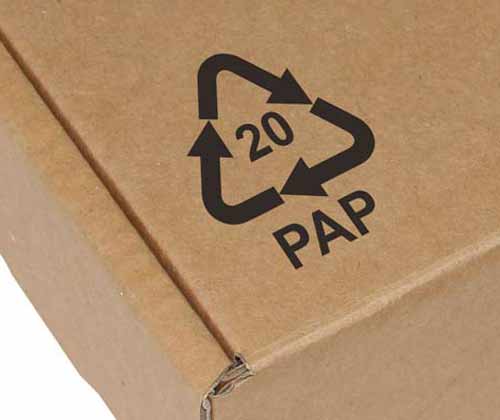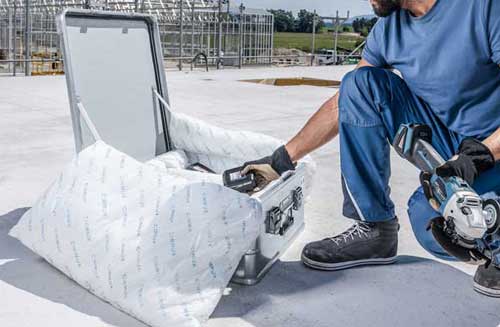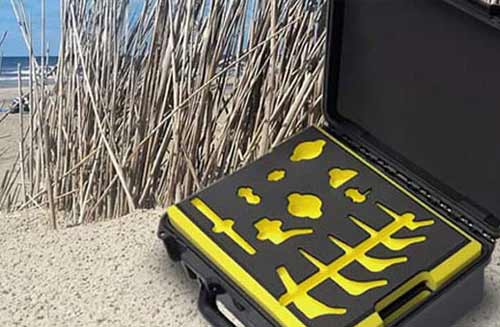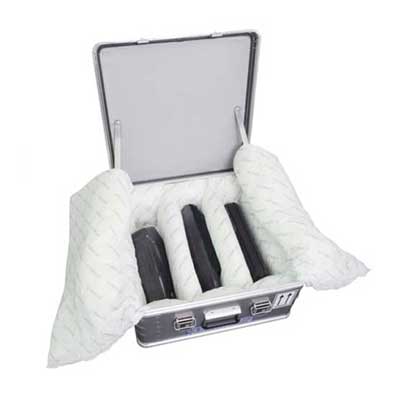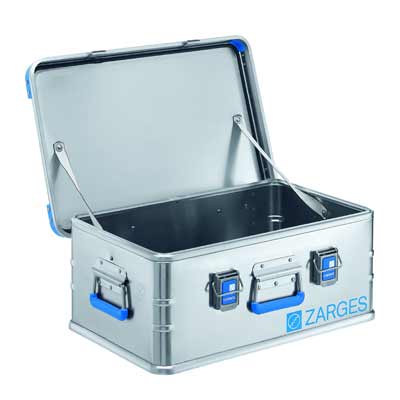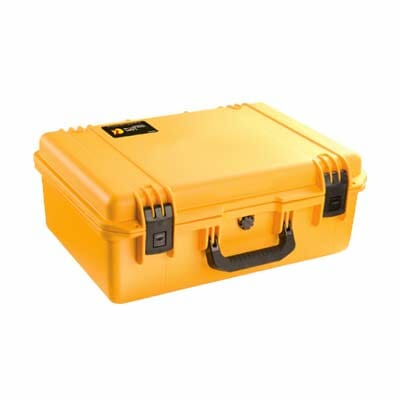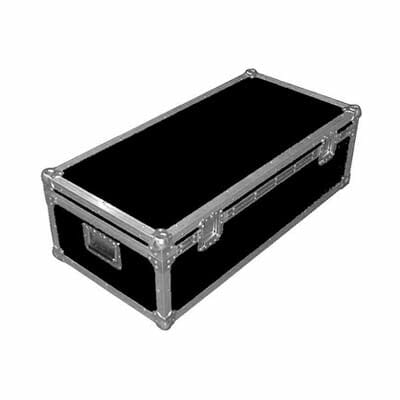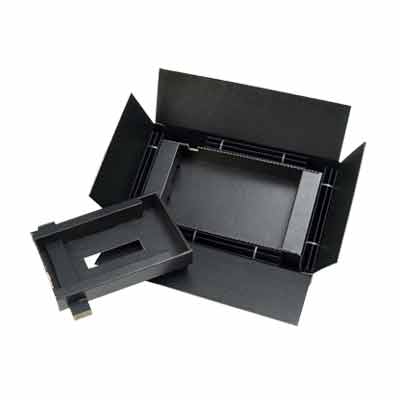Shipping lithium batteries
Transporting lithium batteries by air, sea or road
Many people assume it is safe to ship lithium-ion batteries, but this is not the case.
It is simply not possible to put them into any old box and send them on their way, given the numerous laws and regulations in place to ensure the safety of those transporting them.
In fact, several factors come into play when determining the appropriate packaging and method for transporting lithium-ion batteries.
These are governed by several UN regulations (specifically UN3480, UN3481, and UN3090), as well as rules established by various transport bodies, including the IATA (International Air Transport Association).
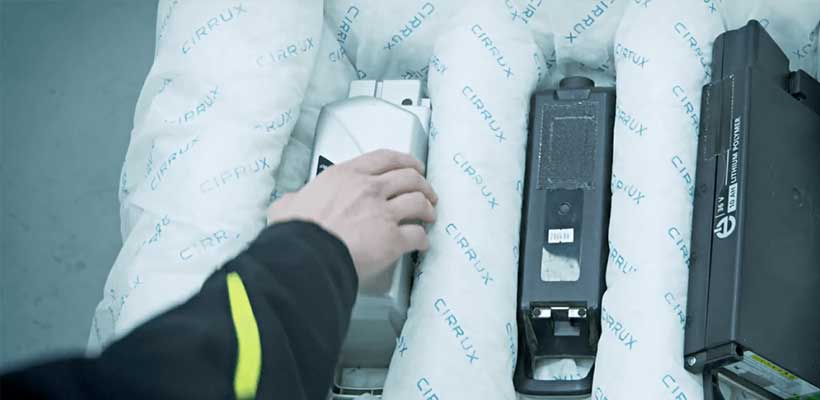
Looking at the list of criteria and influencing factors can be incredibly daunting, which is why this guide aims to provide you with a solid understanding of what is required.
Saying that, if you have any specific questions, then you may also find this list of FAQs regarding lithium battery packaging useful.
Contents
What are lithium batteries?
Explanation of a growing source of energy
As the name suggests, lithium batteries serve as a power source for a wide range of products, appearing in everything from electric cars to power tools and mobile phones.
However, moving beyond the obvious, lithium batteries are commonly categorised into two distinct types: lithium metal batteries and lithium-ion batteries.
Lithium metal batteries
Starting with lithium metal batteries, these are usually non-rechargeable and contain metallic lithium (hence the name).
They typically have a higher “energy density” than similar non-rechargeable batteries, which means they are widely used to power items like calculators, hearing aids, pacemakers and wrist-watches (basically anything where you wouldn’t expect to charge or replace the batteries that often).
Lithium-ion batteries
Lithium-ion batteries are the newer technology; they do not contain metallic lithium, but retain the high energy density of lithium metal batteries, with the added benefit of being rechargeable. Although they are considered more stable and safer than lithium metal batteries, they still pose a significant risk.
Lithium-ion batteries are widely used in various devices, including smartphones, tablets, and laptops.

Problems
Problems with lithium-ion
So, why is shipping lithium-ion batteries such a big deal? And why are there so many UN regulations surrounding this?
Put simply, lithium batteries can be extremely dangerous, meaning they are technically classified as hazardous goods.
Several unexplained aircraft disasters have been attributed to lithium batteries catching fire during flights (including Asiana Airlines 747 near South Korea in July 2011, a UPS 747 in Dubai, UAE in September 2010 and a UPS DC-8 in Philadelphia, PA in February 2006).
These fires are usually attributed to the batteries’ short-circuiting and can result in fire – this is what specialised packaging tailored to these products (such as the Zarges aluminium battery packaging cases) can help contain. Unprotected cells can cause an electrical short by touching, and the propagation of this short can trigger a chain reaction that releases vast amounts of energy.
Lithium batteries can also be prone to “thermal runaway”.
This essentially means that if the internal circuitry is compromised, an increase in internal temperature can occur. At a specific temperature, the battery cells begin to vent hot gases, in turn increasing the temperature in neighbouring cells. Ultimately, this will lead to ignition and combustion, resulting in fire.
As such, large quantities of batteries pose a significant safety risk, which is particularly acute when being shipped by air. A relatively minor incident can escalate into an uncontrollable fire.
As a result, lithium batteries are considered hazardous materials and dangerous goods, and must be handled, stored, and transported accordingly (as set out in UN3480 and the supporting regulations).
Products
Affected products using lithium batteries
Another reason lithium batteries have garnered additional attention is their increasing prevalence.
Now widely used in electric cards, e-bikes, power tools, mobile phones, and a vast range of consumer electronics (from laptops to children’s toys), lithium batteries offer an excellent combination of performance, lightweight design, and efficiency. They are also relatively cost-effective to mass-produce.
However, with increased use comes increased risk. Whilst shipping brand-new batteries within products is relatively safe (although still governed by strict rules), returning damaged or used batteries for repair, recycling, or disposal poses a serious risk.
Additionally, with continued market growth in various products and markets, utilising lithium batteries (with electric car sales expected to surge over the next decade and beyond), the increased risk has prompted regulatory bodies to take action.
UN3480 regulations
Tightening of the rules on shipping lithium batteries
Due to the increased use and associated risk, the rules governing the shipment of lithium batteries (both types) were revised.
As highlighted previously, the danger posed by shipping lithium batteries lies in their potential for short-circuiting. As a result, most new regulations focus on packaging and shipment rules aimed at reducing the potentially catastrophic impact of this.

A very top-level overview of this is as follows:
- Packaging and shipping methods that prevent batteries from coming into contact with each other.
- Packaging and shipping methods that ensure no battery can come into contact with a conductive or metal surface.
- Ensuring all batteries are securely packaged to eliminate movement (within the packaging) during transit, which could potentially cause loosening of terminal caps or inadvertent activation.
UN3480, UN3481, UN3090, and UN3091 classifications
Four pieces of UN legislation effectively cover the shipping of lithium batteries. However, numerous specifics within these can influence the exact process you need to take to ensure safe shipping (or at least minimise the risk as far as possible).
Lithium batteries are now effectively classified as a Class 9 material – termed “miscellaneous dangerous goods”.
The specific UN regulations covering the shipment of these batteries are as follows:
- UN3090, Lithium metal batteries (shipped by themselves).
- UN3480, Lithium-ion batteries (shipped by themselves).
- UN3091, Lithium metal batteries contained in equipment or packed with equipment.
- UN3481, Lithium-ion batteries contained in equipment or packed with equipment.
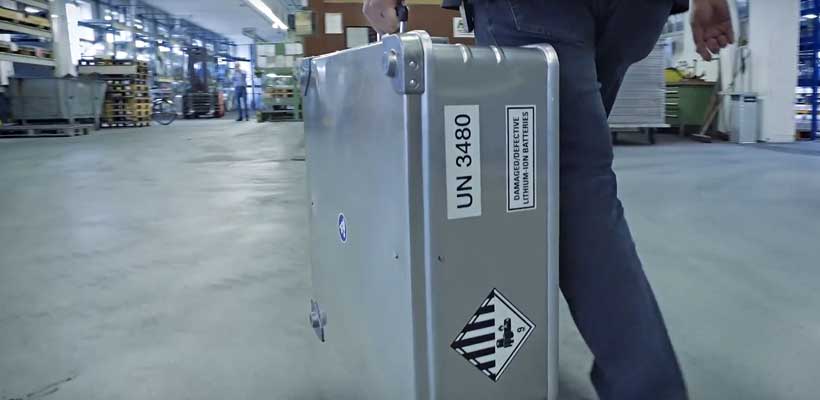
Labelling
Labelling requirements
There are also different labelling requirements for packaging intended for shipping lithium batteries. These requirements differ depending mainly on the following four factors:
- Whether the batteries are contained within the equipment being shipped (such as a watch, calculator, or laptop).
- They are being packed alongside the equipment (like a power tool, packed alongside a spare battery).
- They are being shipped in small quantities (which may be covered by Limited Quantities – the lowest of the four levels of the Carriage of Dangerous Goods).
- They are being shipped in what is defined as minimal quantities, which are not subject to the provisions of the dangerous goods regulations (like two batteries installed in equipment).
For further details, please refer to our downloadable guide.
Technical information
The transit of any dangerous goods (which include lithium batteries) must be organised by people with appropriate training and knowledge, or qualified companies and experts must accompany the shipment itself.
Further technical information, sourced from the UN, IMO (International Maritime Organisation), ADR (the European Agreement Concerning the International Carriage of Dangerous Goods by Road), and IATA (International Air Transport Association) regulations, is presented below.
These set out the points that must be complied with (and checked and adhered to) depending on your mode of transportation.
General rules
Further information on UN3480 and UN3481 regulations
Applicable regulations :
- UN3480, Lithium-ion batteries (shipped by themselves).
- UN3481, Lithium-ion batteries contained in equipment or packed with equipment.
Any lithium-ion batteries to be shipped are the type proven to meet the requirements of each test set out in the UN Manual of Tests and Criteria, Part III, sub-section 38.3.
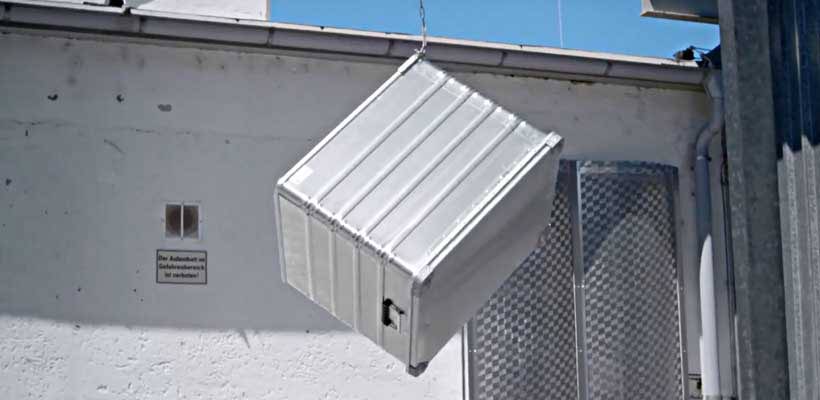
In accordance with the requirements of the UN Model Regulation, Chapter 2.9.4, the manufacturer of the battery or the battery pack shall make available (on request of the Competent Authority) the evidence that a Quality Certification programme is in place in its manufacturing facility for lithium-ion batteries.
ADR/RID requirements
Transit by road
When lithium-ion batteries are shipped by road or rail, they must follow the ADR/RID regulations.
Here’s what that means in simpler terms:
- Class: 9 (Miscellaneous Dangerous Goods).
- Packing group: II (medium level of danger).
- Tunnel category: E (the strictest level – no entry into tunnels of this type).
- Proper shipping name: Lithium-ion batteries, UN3480
- Labels required: Class 9 hazard label.
You’ll also need to follow these ADR special provisions and packing instructions:
- Special provisions: 188, 230, 310, and 636.
- Packing instructions: P903, P903a, and P903b.
Important: If the batteries are damaged or defective, you must contact your National Competent Authority before shipping them.
For detailed regulations, visit the official UNECE website.
IMO requirements
Transit via sea freight
If you’re shipping lithium-ion batteries by sea, you’ll need to comply with the IMO (International Maritime Organisation) rules under IMDG Code.
Here’s a simplified breakdown:
- Class: 9 (Miscellaneous Dangerous Goods).
- Packing group: II
- Proper shipping name: Lithium-ion batteries, UN3480.
- Labels required: Class 9 hazard label.
You’ll also need to follow these IMDG Code provisions:
- Special provisions: 188, 230, and 310.
- Packing instructions: P903.
- EmS (Emergency Schedules): F-A (fire) and S-I (spillage).
- Stowage category: A (can be stored on or under deck in general cargo spaces.
Damaged or defective batteries cannot be shipped without prior approval from your National Competent Authority.
For more information, refer to the IMO website.
IATA-DGR requirements
Transit via air freight
Air transport of lithium-ion batteries is subject to the IATA Dangerous Goods Regulations (DGR), which are generally stricter than the rules for road or sea transport due to the higher safety risks associated with this mode of transportation.
Here’s a breakdown:
- Class: 9 (Miscellaneous Dangerous Goods).
- Packing group: II
- Proper shipping name: Lithium-ion batteries, UN3480
- Labels required: Class 9 hazard label.
You’ll also need to comply with:
- Special provisions: A88, A99, A154, and A164.
- Packing instructions: P965, P966, P967, P968, P969, and P970.
Damaged, defective, or waste batteries are not permitted to be shipped by air under any circumstances.
For the latest IATA guidance, visit the official IATA Lithium Battery Guidance Document.
Further guidance
Further guidance on battery shipping methods
Whilst the technical framework above provides legal instruction on how to ship lithium-ion batteries, this can seem daunting and even confusing for those with no prior knowledge of such legislation.
As such, the following sections provide a simplified overview of the requirements for shipping lithium batteries via different modes of transport.
Shipping lithium batteries by road
If your lithium-ion batteries are being transported by lorry within Europe, you must ensure compliance with all the requirements outlined in the ADR 2017 manual.
This is effectively the European Agreement that governs the shipping of lithium batteries by road and ground (and indeed that of any dangerous goods).

Transporting lithium batteries by train requires meeting a different set of specific guidelines for the transportation of dangerous goods. These regulations are detailed in the Carriage of Dangerous Goods by Rail (RID) guidelines.
These regulations, when coupled with the ADR guidelines used for road transportation, effectively require similar packaging, processes and protections.
Shipping lithium batteries by sea
If shipping lithium batteries via the sea, you will need to comply with the International Maritime Dangerous Goods (IMDG) Code. This document is updated every other year, meaning the 2024 Edition Amendment 41-22 is the current set of regulations.
To review the regulations outlined in the IMDG Code, you must purchase a copy of the Code from the International Maritime Organisation (or work with a packaging supplier familiar with these regulations).

Shipping batteries via mail or courier networks
Even if you are only shipping minimal volumes of lithium batteries (and likely using a courier or mail service), the regulations still apply.
Most couriers have slightly different sets of additional rules and guidelines, but the following points will cover most of the significant points to consider:
- Each package (e.g., a Zarges battery box) cannot contain more than four cells or two batteries if contained within equipment.
- The maximum net quantity of cells or batteries contained in one package cannot exceed 5kg.
- The watt-hour rating must not exceed 30 Wh per cell or 100 Wh per battery.
- Each cell and battery must be a type that has been proven to meet the requirements of each test in the UN Manual of Tests and Criteria, Part III, section 38.3 (as also governed by ADR guidelines).
- Cells or batteries that are defective are forbidden.
- Cells and batteries must be protected against short circuits (e.g., placed in individual, non-conductive packaging).
- The equipment containing cells or batteries must be packed in durable, rigid packaging that is unlikely to be damaged during transit. The items must also be secured against movement within the outer packaging.
- The sender’s name and return address must be made clearly visible on the outer packaging.
Shipping lithium batteries by air
Shipping lithium batteries by air is the most complex form of transport, due to the increased risk (e.g., aircraft accidents caused by fire are likely to be fatal). Given the past instances of damaged batteries being blamed for aircraft crashes, the shipping of damaged or defective batteries is strictly prohibited.
When transporting lithium-ion batteries by air, the Dangerous Goods Regulations (DGR) must be reviewed and complied with. These regulations are governed by the International Air Transport Association (IATA) and the International Civil Aviation Organisation (ICAO).
Responsibility
Who is responsible for safe shipping?
As the company or individual shipping lithium batteries, you are solely and wholly responsible for the shipment. You and your business will be held legally accountable in the event of any accidents caused by the incorrect shipping of batteries or failure to adhere to UN3480 and other relevant regulations.
This is why it is not only critical to select appropriate packaging for your shipment(s), but also to work alongside a packaging supplier that can help and advise on this particular requirement.
Aluminium cases, such as those customised by GWP Protective, can be subjected to the appropriate tests before being put into complete protection, giving you reassurances that your shipments will comply with all regulations.
You can find further details on lithium battery packaging and the solutions available through GWP here.
Summary
The importance of UN3480 anmd UN3090 regulations
Failing to use the proper UN3480-compliant packaging for shipping lithium batteries could have dire consequences for your business. This could extend to significant fines, jail sentences for individuals within your organisation, and the reputational damage of having caused a (potentially fatal) accident.
If you are interested in sourcing Zarges aluminium battery cases tailored for this purpose, please get in touch with our packaging experts at GWP.
Importance notice
The information provided on this page is intended as a guide only. GWP can accept no responsibility or liability for loss, damage or any other consequences of reliance on this information, howsoever caused.
As all applications and scenarios vary, it is your responsibility or the responsibility of your business to ensure that any products or items you ship comply with the regulations applicable to your specific circumstances.
If you have any doubts, please verify with your shipping provider or the relevant regulatory body.
Share this article
Further reading
About the author

Initially joining GWP Protective back in 2004, Richard’s vast, specialist knowledge and experience mean he now heads up the business as General Manager.
Products in this guide
Get in touch
Related guides
UN-approved packaging: Everything you need to know
Shipping lithium batteries – FAQs
The 6 signs you need protective foam inserts
How to pick the best transit case for your applications
8 main causes of equipment damage
Plastazote foam – what is it and should you be using it?
Transit Packaging Symbols (Meanings and Downloads)
Shipping cases: 5 options for safe transit of your goods
What is seaworthy packaging? A detailed guide
Export crating – why it’s essential for international shipping





















